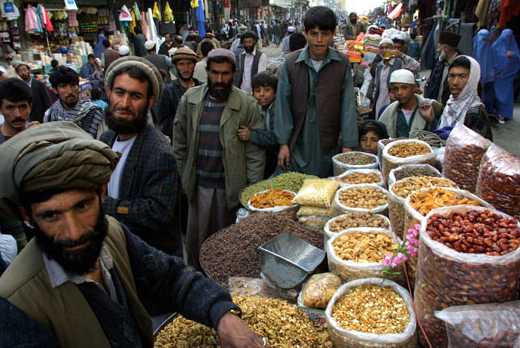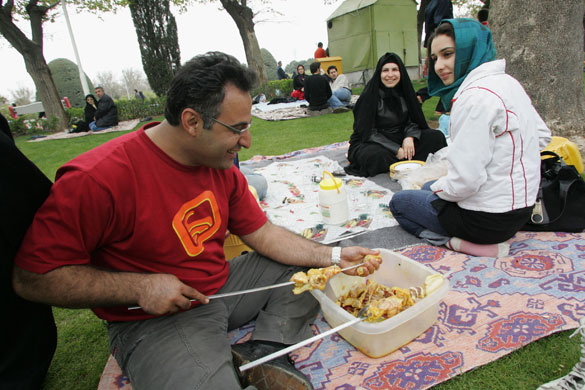I am suspicious of references to “the Arab Street,” particularly when the phase is applied–as it often is–to nations and other vast swaths of territory that are not Arab or not exclusively Arab. Several years ago Christopher Hitchens declared that it was a vanquished cliche, but he was misusing it himself to justify the rush to war by the Bush administration. And he wasn’t speaking of its persistence as a visual convention.
The caption of this photograph at The Guardian says only, “Nowruz celebrations in Afghanistan.” Nowruz is the name of the Iranian New Year, which is celebrated in a number of countries by people of several faiths. The baskets of dried fruits eaten during the holiday provide the only visual connection to the colorful festivities, and you have to know more than the paper tells you to see that. For many viewers, this will a thoroughly conventional image of the Middle East.
That image is one of throngs of working class men massed together in the street. What little business is there is in the open air markets lining each side of the densely packed urban space. We see small batches of everyday goods on display–probably to be bartered for, no less. The open baskets of food are a sure marker of the underdeveloped world. (Imagine how many packages it would take to wrap up that fruit for sale in the US.) Everything fits together into a single narrative, but the masses of men and boys make the scene politically significant. This is the place where collective delusions take hold, where mobs are formed, and where unrest can explode into revolutionary violence and Jihad.
Which is why I get a kick out of this photograph of another Nowruz celebration.
The caption reads, “An Iranian man skewers chicken for grilling as he picnics with his family.” My first thought when I saw the image was to check and make sure it wasn’t taken in Chicago. This also is a very familiar scene: grass, blankets, families and friends, plastic containers of food, dad getting ready to do the grilling.
What is astonishing is that I was able to see them at all. A typical summer holiday photo becomes a radical disruption of Western visual conventions when taken in Iran and shown in the US. Of course, it wasn’t shown in the US: this, too, is from the UK paper.
In this photo, there is no Arab street, and no Iranian masses dominated by Mullahs and demagogues. A middle class tableau reveals that so much of what is in fact ordinary life for many people in Iran and elsewhere in the Middle East is never seen in the US. And it isn’t seen because it doesn’t fit into simplistic categories, outdated stereotypes, and a dominant ideology. All that is shown and implied in the cliches is of course also there, but it is there as part of a much more complex and varied social reality.
As evidence of how things might appear a bit different, notice how seeing the second image can affect perception of the first one. In the second, it seems evident that the family is posing for the photograph. They’re doing exactly what they would have been doing but now with the additional, amused awareness that it is, for a moment, also an act. And sure enough, if you look back to the first photo, you can see the same thing. And if you can see that, they no longer need appear as a mass, or poor, or threatening, or anything but people enjoying a holiday. Much like people in the US were doing this past weekend to celebrate St. Patrick’s day, thronged together, in the street.
Photographs by Natalie Behring-Chisholm/Getty Images and Behrouz Mehri/AFP-Getty Images.


“The open baskets of food are a sure marker of the underdeveloped world.”
That’s an unfortunate generalisation, unless you count Japan and Singapore amongst others as underdeveloped. I would attribute this particular way of displaying food to cultural differences, rather than socio-economic discrepancies.
Siew: Correction noted. In fact, we have open air markets in the US during the summertime, and fruits and vegetables always are displayed that way in grocery stores throughout the year. I was referring more to photographic conventions and typical perceptions in the US than to actual practices of selling food. The open baskets are shown repeatedly in photos of the underdeveloped world, while the open bins in a grocery store are not shown and never compared with the foreign display. The structural binary of the raw and the cooked is recoded as unpackaged and packaged.
[…] Robert Hariman studies two U.K. press photos of the Middle East and contrasts them with the U.S. press: In this […]
[…] you want the answers, you’ll have to check the site which originally posted them, No Caption Needed. It’s a good place to visit regularly, to inoculate yourselves against the incompetence, the […]
You made a great work comparing these two pictures and the differents ways to approach the reality of the Middle East -like other realities- from the media. If we could identify and avoid the cliches we could show another way of seeing our world. Complex is beautiful.
Hi,
Super post, Need to mark it on Digg
Thanks
Joker
[…] We’re pleased to feature a post by Robert Hariman. Robert is a professor of Rhetoric and Public Culture in the Department of Communication Studies of Northwestern University. Robert blogs at No Caption Needed, where we saw this great post: […]
I can’t make heads or tails of this post. Both of these pictures are from The Guardian but the author uses them to make a point about the depiction of the Middle East in American media. There is no attempt, however, to actually show how Nowruz is represented America. As an actual example, here is a story from the New York Times. Check out the slide show embedded in the story. Most of the photos are of seemingly middle-class Tehranians doing all sorts of shopping (what could be more Western than that?). It certainly seems to run counter to the author’s claim about what can’t be seen here.
Joe: If you think one exception disproves a habit, you are likely to have a hard time making sense of most of what we say at this blog. John and I often discuss patterns, tendencies, probabilities–in short, conventions of media production and reception. I’m glad to see the Times slide show–which clearly is a step in the right direction precisely because it goes against the tendency to show much of the region as relatively primitive or only fitfully modernized. And I stand corrected: I should not have implied that this more comprehensive view is never available. It often is not there, however, and particularly outside the Times, while the more typical view is widely reproduced–including at the Times, which has even resorted to a black and white slide show that made street life in Afghanistan look like something out of the 19th century. In any case, I assume that we can agree on the techniques used to make another country appear more of less modern. I also wonder if the US government’s “tilt” toward Iran is now being reflected in Times coverage. That might be another reason to continue to monitor the slide shows.
I recently came across your blog and have been reading along. I thought I would leave my first comment. I don’t know what to say except that I have enjoyed reading. Nice blog. I will keep visiting this blog very often.
Joannah
http://easypowerpaint.com
Hello
First photo is not related to Iran. This photo belongs Afghanistan. Afghan men are seen in this photo.
Thanks
Mari: You are correct but not providing a correction, for I stated that the photo was taken in Afghanistan. Your point is a good one, however, and what I was trying to say: we should recognize that the Middle East, like anywhere else, is more heterogeneous than is evident to an outsider reading typical press coverage.